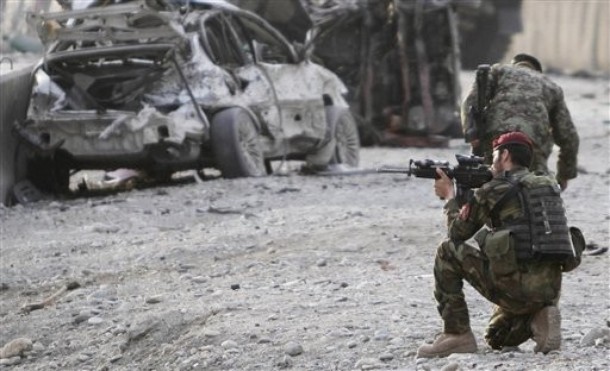
The number of ISAF (International Security Assistance Force) soldiers killed by their Afghan counterparts has risen precipitously this year. So-called “green on blue” attacks have killed 42 soldiers, more than the 35 killed last year and twice as many as were killed in 2010. Officials are scrambling to figure out why.
The American current strategy in Afghanistan is based on what’s called the ‘transition:’ the process of transitioning the security responsibility of Afghanistan to Afghans by the end of 2014. ISAF has spent the last three years feverishly training the Afghan security forces, and expects to have 350,000 troops ready by the end of the transition process.
The killings have some worrying implications; those same Afghans being trained by Americans are the ones turning their guns on Coalition troops. Though there is no inidiation yet what, if any, affect these killings have on morale, two weeks ago the military ordered personnel be armed at all times – even inside, on base – to safeguard against a potential Afghan shooting rampage.
Unfortunately, there is every reason to assume these sorts of attacks will continue. With distrust built into the transition strategy, there is obvious tension inherent to the training relationship and growing cynicism about the post-2014 outlook there.
Start with the difficulty of understanding who is being recruited. The Afghan government issues a government-ID through a bureaucratic process and requires signatures from witnesses. The system, however, is full of holes; there is little way to ensuring genuine IDs and few if any know how many IDs have ever been issued. The US can keep track of who’s working for the Afghan security forces through sophisticated biometric scans but only 2.5 million of Afghanistan’s estimated 33 million people have been so far scanned.
An infiltration of Taliban soldiers is another large problem- one they even brag of. Recent reporting from Newsweek suggests Taliban dissemination is getting worse. Several Afghan officers complained, “The Taliban are hunting two birds with one arrow: they are killing coalition soldiers while at the same time hurting working relations between our allied forces.”
Additionally, once an Afghan joins the Americans, there is extreme stress in the relationship with trainers. A recent unclassified report by a “Red Team,” (a military unit who analyze military policy) noted that Afghans complain their American mentors are “extremely arrogant, bullying, unwilling to listen to their advice, and were often seen as lacking concern for civilian and [Afghan] safety during combat.”
This fundamental problem within the transition strategy is contributing to the distrust between Afghans and Americans. Even the non-Taliban who join are rarely much educated – they start their short training course by learning how to read at an elementary school level. Developing volunteers into field-capable soldiers and policemen is much more difficult and slower than in the US, often contributing to American soldiers feelings less confident about the Afghans’ abilities post 2014.
Neither is the military is properly preparing its soldiers for the cultural challenges of training. The recent investigation into February’s Koran burnings is instructive: it turns out those military guards burned over 100 Korans, not a few as the military originally reported. It also turns out the soldiers thought the Koran was just extremist literature being used to radicalize the inmates at the Bagram prison. Moreover, those guards dismissed the concerns of their Afghan colleagues, who begged them not to destroy the holy books.
This type of mistake, coupled with the tension between US and Afghan soldiers only happens in the absence of training and in a vacuum of leadership. Sadly, leadership is still sorely lacking. An ISAF official recently tried to blame the rise in green-on-blue attacks on Ramadan, as if it was the pressures of Islam and not the tensions of the training relationship that had prompted murder.
But the real answer can be found much more plainly. Pay attention to the next news story you read about Afghanistan. A typical story, with a picture attached, will contain detailed biographical details of the Americans who are there: names, ages, hometowns, regiments, and so on. The Afghans, though, are often nameless – alongside their named American colleagues, but denied names, homes, and individual identities.
This type of treatment belies an assumption built into America’s relationship with Afghanistan. Transitioning to full Afghan control requires respect to run both ways. While most Afghans one can speak with express respect for America, it’s less common to find many Americans expressing respect for Afghanistan. Such contempt will continue to poison our plans there, and will ultimately make any American victory eked out a hollow one.
Joshua Foust is a fellow at the American Security Project and the author of Afghanistan Journal: Selections from Registan.net. He is a member of the Atlantic Council’s Young Atlanticist Working Group, and used to work as a civilian cultural advisor for the US Army. This article originally appeared in PBS Need to Know.
Image: afghansoldierjalalabad.jpg
